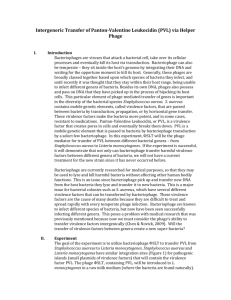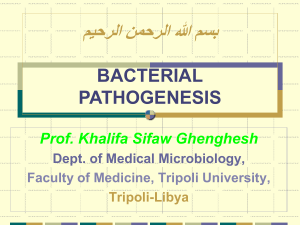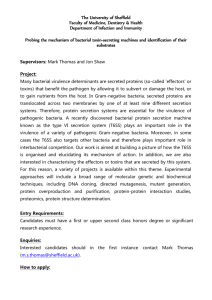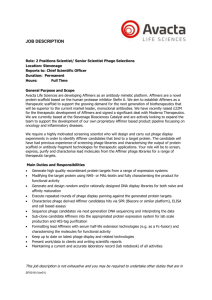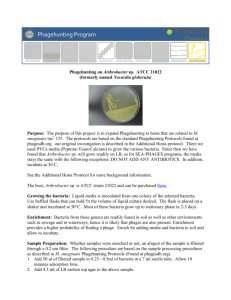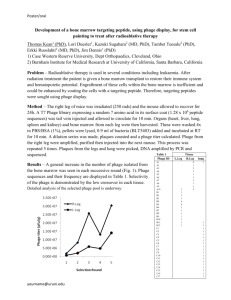Intergeneric transfer of Panton-Valentine Leukocidin
advertisement
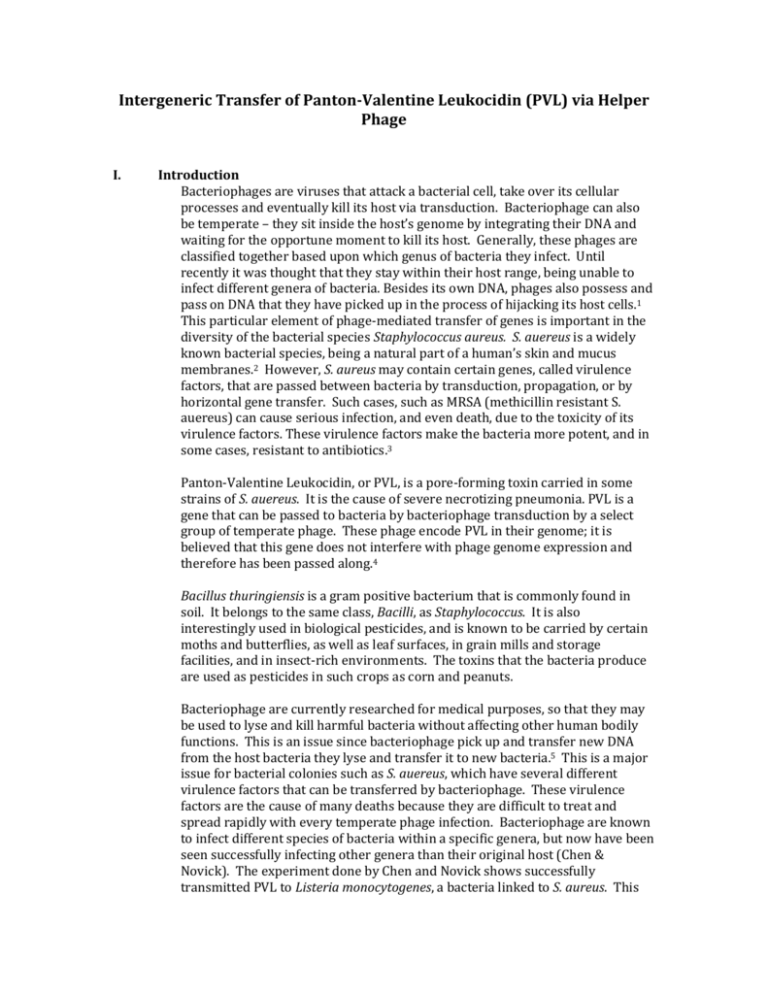
Intergeneric Transfer of Panton-Valentine Leukocidin (PVL) via Helper Phage I. Introduction Bacteriophages are viruses that attack a bacterial cell, take over its cellular processes and eventually kill its host via transduction. Bacteriophage can also be temperate – they sit inside the host’s genome by integrating their DNA and waiting for the opportune moment to kill its host. Generally, these phages are classified together based upon which genus of bacteria they infect. Until recently it was thought that they stay within their host range, being unable to infect different genera of bacteria. Besides its own DNA, phages also possess and pass on DNA that they have picked up in the process of hijacking its host cells.1 This particular element of phage-mediated transfer of genes is important in the diversity of the bacterial species Staphylococcus aureus. S. auereus is a widely known bacterial species, being a natural part of a human’s skin and mucus membranes.2 However, S. aureus may contain certain genes, called virulence factors, that are passed between bacteria by transduction, propagation, or by horizontal gene transfer. Such cases, such as MRSA (methicillin resistant S. auereus) can cause serious infection, and even death, due to the toxicity of its virulence factors. These virulence factors make the bacteria more potent, and in some cases, resistant to antibiotics.3 Panton-Valentine Leukocidin, or PVL, is a pore-forming toxin carried in some strains of S. auereus. It is the cause of severe necrotizing pneumonia. PVL is a gene that can be passed to bacteria by bacteriophage transduction by a select group of temperate phage. These phage encode PVL in their genome; it is believed that this gene does not interfere with phage genome expression and therefore has been passed along.4 Bacillus thuringiensis is a gram positive bacterium that is commonly found in soil. It belongs to the same class, Bacilli, as Staphylococcus. It is also interestingly used in biological pesticides, and is known to be carried by certain moths and butterflies, as well as leaf surfaces, in grain mills and storage facilities, and in insect-rich environments. The toxins that the bacteria produce are used as pesticides in such crops as corn and peanuts. Bacteriophage are currently researched for medical purposes, so that they may be used to lyse and kill harmful bacteria without affecting other human bodily functions. This is an issue since bacteriophage pick up and transfer new DNA from the host bacteria they lyse and transfer it to new bacteria.5 This is a major issue for bacterial colonies such as S. auereus, which have several different virulence factors that can be transferred by bacteriophage. These virulence factors are the cause of many deaths because they are difficult to treat and spread rapidly with every temperate phage infection. Bacteriophage are known to infect different species of bacteria within a specific genera, but now have been seen successfully infecting other genera than their original host (Chen & Novick). The experiment done by Chen and Novick shows successfully transmitted PVL to Listeria monocytogenes, a bacteria linked to S. aureus. This poses a problem with medical research because now we must consider the phage’s ability to transfer virulence factors intergenically Will the transfer of virulence factors between genera create a novel strain of bacteria? In this experiment, ФPVL will be the phage mediator for transfer of PVL between different bacterial genera – from Staphylococcus aureus to Bacillus thuringiensis. If the experiment is successful, not only can bacteriophage transfer harmful virulence factors between different genera of bacteria, but also further analysis of bacteriophage therapy would need to be considered. II. Experiment The goal of the experiment is to utilize bacteriophage ФPVL to transfer PVL from Staphylococcus auereus to Bacillus thuringiensis. Staphylococcus auereus and Bacillus thuringiensis have similar attB sites, or sites in the genome that the phage recognizes for integration (Figure 1, 3). The phage ФPVL, containing the virulence factor PVL, will be introduced to Bacillus thuringiensis. After infection, the phage plaques will be streaked for surviving bacterial colonies. These colonies will contain the prophage, the integrated ФPVL genome in B. thuringiensis. The bacteria will be isolated, and its DNA collected using techniques from Chen & Novick. The known integration sites, shown in figure 1, will be cut with restriction enzymes EcoRI and HindIII(enzymes that cut at a specific sequence on DNA) and amplified using PCR (polymerase chain reaction) which replicates the piece of DNA under speculation using specifically designed primers (Figure 2). An agarose gel will be electrophoresed, causing the DNA bands to travel down the gel according to size of fragments. The fragment size will determine if the virulence factor has integrated into B. thuringiensis. The PCR should show a fragment size approximately 41kb, so an extended DNA ladder should be used to verify in the agarose gel. If no fragment is amplified, the phage may not have integrated successfully. To conclude that it has in fact integrated, the fragment should be sent to a facility to be sequenced. Further tests could be done on mice to determine if PVL is operational inside of its new bacterial host, or if the DNA was simply integrated and not active. Figure 1: DNA sequences of attP, attR, attL, and attB sites. Sequences originating from phiPVL are in uppercase letters, and sequences derived from the bacterial host are shown in lower case letters. The core base pair sequences are underlined. Figure adapted from reference 6. Figure 2: PCR primers generated using BLAST. See reference 7. Figure 3: BLAST showing homology in attB sequences between ФPVL and B. thuringiensis. See reference 7. III. Discussion If the experiment is successful, integration of the virulence factor PantonValentine Leukocidin will have integrated into a new genera of bacteria, Bacillus thuringiensis. The virulence factor will be tested for the activity of PVL and its ability to create pores in the infected host’s cells. The introduction of such a potent virulence factor to a new genera poses several issues from lack of treatment to potential pandemic. Phage treatment for medical purposes will have to be re-examined for the threat of possible transduction of other potentially negative virulence factors between bacterial genera. As long as integration sites are similar, the possibilities of other genera of bacteria having the ability to pick up these virulence factors will be endless. This experiment could prove that PVL be completely inactive in its new bacterial host, but this doesn’t mean that it couldn’t once again be transferred to yet another genera of bacteria, or encounter the right environmental conditions to evolve and become active. IV. References 1. Comparative Genomic Analysis of 60 Mycobacteriophage Genomes: Genome Clustering, Gene Acquisition, and Gene Size. Hatfull, et al. J. Mol. Biol. (2010) 397, 119–143 2. An Innate Bactericidal Oleic Acid Effective Against Skin Infection of Methicillin-Resistant Staphylococcus aureus: A Therapy Concordant with Evolutionary Medicine. Chen, et al. J. Microbiol. Biotechnol. (2011), 21(4), 391– 399 doi: 10.4014/jmb.1011.11014 First published online 16 January 2011 3. Phage-Mediated Intergeneric Transfer of Toxin Genes. John Chen and Richard P. Novick, 2009. Science 2 January 2009: Vol. 323 no. 5910 pp. 139-141. DOI: 10.1126/science.1164783 4. Lo ̈ffler B, Hussain M, Grundmeier M, Bru ̈ck M, Holzinger D, et al. (2010) Staphylococcus aureus Panton-Valentine Leukocidin Is a Very Potent Cytotoxic Factor for Human Neutrophils. PLoS Pathog 6(1): e1000715. doi:10.1371/journal.ppat.1000715 5. TB: the return of the phage. A review of fifty years of mycobacteriophage research R. McNerney. Department of Infectious and Tropical Diseases, London School of Hygiene & Tropical Medicine, London, UK. NT J TUBERC LUNG DIS 3(3):179–184 © 1999 IUATLD. 6. Complete nucleotide sequence and molecular characterization of the temperate staphylococcal bacteriophage φPVL carrying Panton–Valentine leukocidin genes. Kaneko, et al. Gene. Volume 215, Issue 1, 17 July 1998, Pages 57–67 7. BLAST – Basic Local Alignment Tool by NCBI: http://www.ncbi.nlm.nih.gov 8. Fatal S. aureus Hemorrhagic Pneumonia: Genetic Analysis of a Unique Clinical Isolate Producing both PVL and TSST-1. Li et al. PLoS One. 2011; 6(11): e27246. 9. Phage conversion of Panton-Valentine leukocidin in Staphylococcus aureus: molecular analysis of a PVL-converting phage, phiSLT. Narita et al. Gene. 2001 May 2;268(1-2):195-206. 10. Identification of ORF636 in phage phiSLT carrying Panton-Valentine leukocidin genes, acting as an adhesion protein for a poly(glycerophosphate) chain of lipoteichoic acid on the cell surface of Staphylococcus aureus. Kaneko, et al. J Bacteriol. 2009 Jul;191(14):4674-80. Epub 2009 May 8. 11. Panton-Valentine Leukocidin. Venkata Meka, M.D. (http://www.antimicrobe.org/h04c.files/history/PVL-S-aureus.asp ) 12. ApE – A plasmid Editor http://biologylabs.utah.edu/jorgensen/wayned/ape/. By M. Wayne Davis. Updated July 30, 2012.
